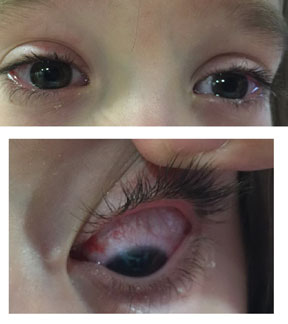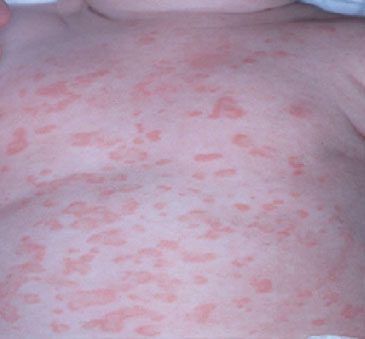8-year-old female presents with persistent fever, transient rash, erythematous oropharynx
An 8-year-old female with a significant past medical history of moderate persistent asthma and primary ciliary dyskinesia was seen in her primary clinic following several days of fever, cough, headache and emesis. At that visit, her posterior pharynx was noted to be mildly erythematous; however, she reported no significant pain, and a rapid streptococcal screen was negative. Her respiratory virus panel was positive for adenovirus.


After 2 more days of fever and persistence of symptoms, the patient was taken to an outside hospital emergency department with fever of 106.1°F (ongoing for 6 days), rhinorrhea, congestion and intermittent rash. The rash was described as large patches of irregular shaped erythema on various places, primarily on her trunk, with minimal involvement of the extremities; no pustules, vesicles or blisters were seen. The rash seemed to wax and wane with fever spikes but was not seen at the time of admission. There were no other abnormal findings reported from the referring ER.

Source: Pham T

Lab results from the referring ER included a urinalysis showing pyuria, with 20 to 50 WBCs and a negative culture. The patient’s metabolic profile was normal, including liver enzymes, albumin and chemistries; her CBC was also normal and her CRP was 21.1.
Her physical exam on hospital admission was unremarkable except for mild bilateral nonexudative conjunctivitis (Figure 1); the rash and mucous membrane inflammation had resolved. Considering these historic and current findings with 6 days of ongoing fever, an echocardiogram was performed, showing mild ectasia (3.2 mm, z score +2.7) of the proximal right coronary artery (Figure 2), with no other abnormalities seen.
In summary, this is an 8-year-old female with 6 days of fever, upper respiratory tract infection symptoms, bilateral nonexudative conjunctivitis, transient rash and erythematous oropharynx noted 2 days before with elevated CRP, pyuria and mild ectasia of the right coronary artery. The patient also exhibited evidence of a recent or current adenovirus infection by PCR.
What’s your diagnosis?
A. Severe adenovirus infection with myocarditis
B. Acute rheumatic fever
C. Incomplete Kawasaki disease
D. Systemic-onset juvenile idiopathic arthritis
Click to the next page to confirm your answer.
Case Discussion
The answer turned out to be incomplete Kawasaki disease (C), and the patient received IVIG and high-dose aspirin soon after the results of the echocardiogram were known. However, because of ongoing fever, she received a second dose, with subsequent rapid improvement. According to an article by Newburger and colleagues published in Pediatrics in 2004, the term “incomplete” may be preferable to “atypical” because these patients lack sufficient clinical signs of the disease to fulfill the classic criteria; they do not demonstrate atypical clinical features. Unusual or incomplete cases tend to be more common at the extremes of age, rather than falling within the average age of 18 to 24 months.
This 8-year-old is the oldest patient we have documented with Kawasaki disease at this institution. Our previous oldest case was a 7-year-old with only conjunctivitis, whose Kawasaki disease was confirmed by early aneurysm formation on echocardiogram; our youngest patient was a 7-week-old female who presented with several days of fever and a rash (Figure 3). This patient had no other compatible physical findings, and was initially thought to have a rash-producing viral infection; however, on outpatient follow up, she was found to still be febrile, and a CBC revealed a platelet count of more than 1 million, and she was re-admitted. Her echocardiogram was grossly abnormal with giant aneurysms.
When faced with a case that is unclear, the AAP has published a very handy algorithm in the 2015 Red Book that can guide you through the process of sorting out this confusing condition.

Adenovirus is a common cause of exudative tonsillitis and exudative conjunctivitis in children, and can be associated with prolonged fever, but usually not this long. Additionally, one would not expect to see dry conjunctival inflammation or ectasia on an echocardiogram. Echocardiography in viral myocarditis should show muscle dysfunction and hypertrophy, which was not the case here.
Likewise, acute rheumatic fever carditis would not be expected to have ectasia. Also, the patient would not have fit the Modified Jones Criteria for this diagnosis.
Lastly, patients with systemic-onset juvenile idiopathic arthritis almost always present with fever of unknown origin and are likely to have multisystem disease manifestations, which may include heart inflammation, but Kawasaki disease is the best choice given the information above.
- For more information:
- James H. Brien, DO, is with the department of infectious diseases at McLane Children’s Hospital, Baylor Scott & White Health, Texas A&M College of Medicine in Temple, Texas. He also is a member of the Infectious Diseases in Children Editorial Board. Brien can be reached at: jhbrien@aol.com.
Disclosure: Brien reports no relevant financial disclosures.
Columnist Comment
I want to thank Thu Pham, DO for serving as the guest columnist this month. She is a third-year pediatric resident in our program. She graduated with BS in biology at University of Houston and went on to attend medical school at my alma mater, the University of North Texas Health Science Center, Texas College of Osteopathic Medicine in Fort Worth.
